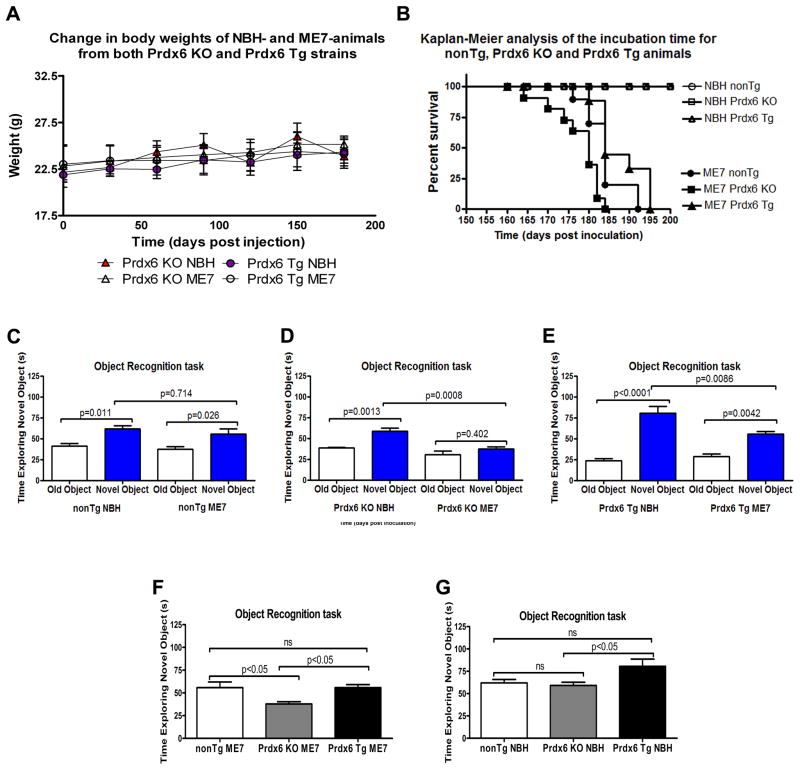Figure 3.
(A) Cohorts of n = 12 were set up for the study. Animals were weighed monthly to determine if there were any atypical changes prior to eventual clinical disease onset. In the course of the study there were no significant differences in the weights of the animals. Prdx6 Tg animals weighed 22.16±0.28g, while Prdx6 KO animals weighed 21.88±0.31g respectively. (B) Shows prolonged survival in Prdx6 Tg animals with established prion disease. Starting at 120 dpi both NBH- and ME7-animals were tested weekly for signs of ataxia, characteristic of neuroinvasion and disease onset. Animals were sacrificed after 3 weeks of positive scoring. Differences in Kaplan-Meier survival curves of NBH and ME7 (nonTg, Prdx6 KO and Prdx6 Tg) were analyzed by the Log-rank test. All NBH and ME7 plots were significantly different (p<0.0001). Although nonTg ME7 compared to Prdx6 Tg ME7 was not significantly different (Mantel-Cox=2.842, df=1, p=0.0918, hazard ratio (HR) = 1.757), nonTg ME7 compared to Prdx6 KO ME7 was significantly different (Mantel-Cox=7.58, df=1, p<0.0059, hazard ratio (HR) = 0.39). Prdx6 KO ME7 compared to Prdx6 Tg ME7 was also significantly different (Mantel-Cox=12.70, df=1, p<0.0004, hazard ratio (HR) = 3.41). Prdx6 KO ME7 animals died within 150–185 dpi, while nonTg ME7 and Prdx6 Tg ME7 animals survived longer, living up to 192 and 195 dpi, respectively. The healthy NBH-animals were killed after 216 days. (C) Prior to sacrificing, mice underwent a mild cognitive test (novel object recognition task). Both nonTg ME7-animals and nonTg NBH-animals could discriminate novel from old objects (p=0.011 and p=0.026, respectively) and there was no difference in their ability to discriminate novel objects (p=0.714). (D) Prdx6 KO NBH-animal could significantly discriminate novel from old objects (p=0.0013), whereas Prdx6 KO ME7-animals could not (p=0.402), and Prdx6 KO NBH-animal spent significantly more time with the novel objects than Prdx6 KO ME7-animals (p=0.0008). (E) Both Prdx6 Tg ME7-animals and Prdx6 Tg NBH-animals could discriminate novel from old objects (p=0.0001 and p=0.0042, respectively) but Prdx6 Tg NBH-animals spent significantly more time with the novel object than Prdx6 ME7-animals (p<0.0001). (F) ME7 Prdx6 KO animals spent the least time with the novel objects, in contrast to nonTg ME7 and Prdx6 Tg ME7-animals (37.8% compared to 55.7%, and 55.8% for nonTg and Prdx6 Tg respectively). (G) Although all cohorts of NBH-animals were able to discriminate novel objects, Prdx6 Tg NBH-animals showed the most preference for the novel objects (80.56% compared to 62%, and 59% for non Tg and Prdx6 KO respectively).

